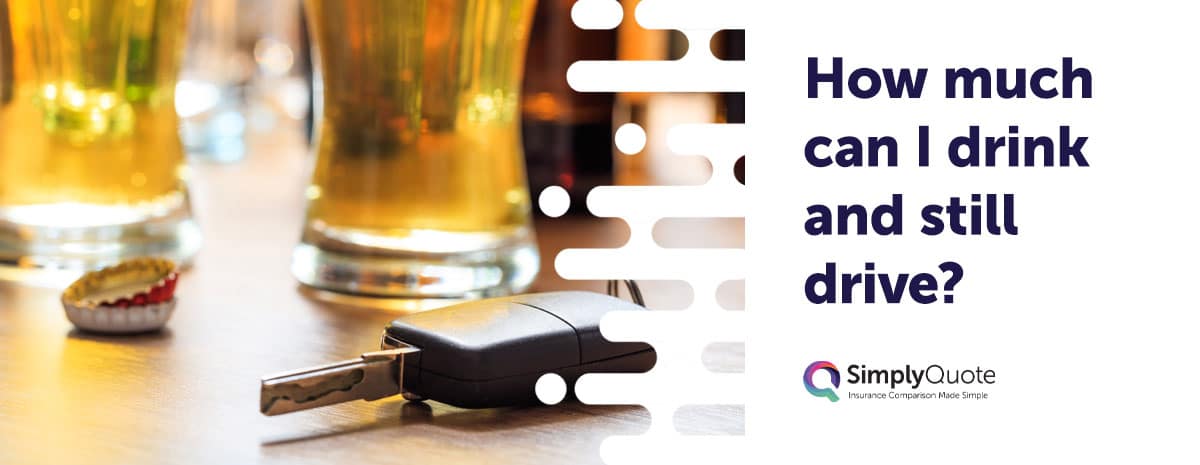How much can I drink and still drive?
In the United Kingdom, the legal alcohol limit for driving varies depending on where you are:
In England, Wales, and Northern Ireland: The legal limit is 80 milligrams of alcohol per 100 millilitres of blood or 35 micrograms of alcohol per 100 millilitres of breath.
In Scotland: The limit is stricter, with 50 micrograms of alcohol per 100 millilitres of blood and 22 micrograms of alcohol per 100 millilitres of breath.
However, it’s essential to note that the effects of alcohol can vary based on several factors, including weight, age, metabolism, and the amount of food consumed. Therefore, even if you’re below the legal limit, you might still be impaired and unsafe to drive. The safest approach is not to drink and drive at all.
Additionally, being over the drink driving limit can have serious consequences, not only in terms of legal penalties but also for your car insurance premiums. According to the UK Government website, around 280 deaths in 2019 were attributed to drivers being over the drink driving limit.
Let’s explore this topic further.

What is a Unit of Alcohol?
A unit of alcohol is a standardised measure used in the United Kingdom to quantify the amount of pure alcohol in an alcoholic beverage.
One unit of alcohol is equivalent to 10 millilitres (or 8 grams) of pure alcohol.
To put this into perspective:
- A typical pint of beer (with 4% alcohol by volume) contains around 2.3 units of alcohol.
- A standard 25ml shot of spirits (with 40% alcohol by volume) is approximately one unit.
- A 175ml glass of wine (with 12% alcohol by volume) has about 2.1 units.
However, it’s essential to understand that the number of units in a drink can vary based on its size and alcohol content. For instance, stronger beers or larger wine glasses will contain more units.
Units are a helpful way to gauge alcohol consumption, but they should be used as a rough guide. The effects of alcohol can differ from person to person due to factors like metabolism, weight, and age. Therefore, while units can provide a general idea of alcohol intake, they don’t necessarily indicate how intoxicated or impaired an individual might be.
Looking for cheap car insurance? Get your quote today!
Get QuotesHow many units can I drink & still drive legally in the UK?
In the United Kingdom, the legal alcohol limit for driving is as follows:
- In England, Wales, and Northern Ireland: The drink-driving alcohol limit is 80 milligrams of alcohol per 100 millilitres of blood. This roughly equates to around 3 units of alcohol for women and 4 units for men.
- In Scotland: The limit is stricter, with 50 micrograms of alcohol per 100 millilitres of blood.
However, it’s crucial to understand that the number of units one can consume and still drive safely varies significantly based on individual factors. Your sex, weight, age, diet, metabolism, and even stress levels can influence how your body processes alcohol. For instance, while some people might feel okay to drive after two pints, others might feel impaired after just one.
As a general guideline, adults process, on average, one unit of alcohol per hour. For example, if you consume a single shot of spirits, which is roughly one unit of alcohol, you’d need to wait at least one hour before driving. But remember, alcohol levels in your bloodstream can continue to rise for up to three hours after drinking, depending on various factors.
Given these complexities, the safest advice is always: if you plan to drink, don’t drive.
How many units of alcohol are there in a pint of beer?
A pint of beer’s alcohol content can vary based on its strength, but here’s a general guideline for the UK:
- Pint of lower-strength lager/beer/cider (ABV 3.6%): 2 units.
- Pint of higher-strength lager/beer/cider (ABV 5.2%): 3 units.
It’s essential to note that the actual number of units can differ based on the specific beer and its alcohol by volume (ABV). For instance, a pint of a beer with an ABV of 4% will have a different unit count than one with an ABV of 6%. Always check the label or ask the server for the specific ABV of the beer you’re drinking to get a more accurate unit count.
Furthermore, while knowing the number of units in a drink can help gauge alcohol consumption, it’s crucial to remember that individual factors like metabolism, weight, and age can influence how alcohol affects you. As such, even if you consume an amount below the legal limit, you might still be impaired and unsafe to drive.
How many units of alcohol are in a glass of wine?
A typical-strength medium (175ml) glass of wine contains around 2.3 units of alcohol.
However, the number of units in a glass of wine can vary based on its size and the wine’s alcohol by volume (ABV). For instance:
- A large glass of wine (250ml) with an ABV of 13% contains approximately 3.3 units.
- A small glass of wine (125ml) with an ABV of 12% would have fewer units.
It’s essential to check the label or ask the server for the specific ABV of the wine you’re drinking to get a more accurate unit count. Given that the recommended weekly alcohol limit in the UK for both men and women is 14 units, it’s crucial to be aware of your consumption, especially if you’re planning to drive.
How do you calculate the number of units in a drink?
To calculate the number of units in a drink, you can use the following formula:
Number of Units = (Volume in ml × Alcohol by Volume (ABV) as a percentage) ÷ 1,000
For example:
This formula allows you to determine the alcohol content in any drink based on its volume and ABV. It’s essential to note that the ABV can vary between different brands or types of the same alcoholic beverage, so always check the label for the most accurate information.
Understanding the number of units in a drink can help individuals make informed decisions about their alcohol consumption, especially if they are considering driving or want to monitor their intake for health reasons.
How much can I drink the night before driving?
The safest advice regarding drinking the night before driving is: if you plan on driving the next day, it’s best not to drink any alcohol the night before.
How the Body Processes Alcohol
The human body processes, on average, about one unit of alcohol per hour. However, this rate can vary based on several factors, including weight, age, sex, metabolism, and the amount of food consumed. It’s a misconception that you can speed up this process with methods like drinking coffee, taking a cold shower, or eating a big breakfast. These might make you feel more awake or alert but won’t reduce the alcohol content in your bloodstream.
Understanding Personal Limits and Risks
It’s essential to understand that even if you feel fine the morning after drinking, your blood alcohol concentration (BAC) could still be over the legal limit, making you unfit to drive. Driving under the influence increases the risk of accidents, and you could face severe penalties, including fines, a driving ban, or imprisonment if caught.
Factors like stress, fatigue, and the use of medications can further impair your ability to drive, even if your BAC is below the legal limit. Given the potential risks and the variability in how different individuals process alcohol, the most responsible approach is to avoid driving altogether if you’ve consumed alcohol the night before.
What are the dangers of driving over the drink-drive limit?
Driving over the drink-drive limit poses severe dangers, both to the driver and others on the road. Thousands of people are killed or seriously injured in road accidents every year because at least one driver is over the drink-drive limit.
Impaired Judgement and Slower Reaction Times
Alcohol affects the brain’s ability to process information, leading to slower reaction times and impaired judgment. This can result in drivers being unable to respond quickly to unexpected situations on the road.
Reduced Concentration
Alcohol can reduce a driver’s ability to concentrate, making it harder to keep track of the road, other vehicles, and pedestrians.
Decreased Vision
Alcohol can blur vision and make it difficult for drivers to judge distances and speeds accurately.
Legal Consequences
In the UK, driving or attempting to drive while above the legal limit can result in penalties such as imprisonment, hefty fines, and a driving ban.
Financial Implications
Apart from legal fines, a drink driving conviction can lead to increased car insurance premiums, making it more expensive for the convicted driver to get insured in the future.
Long-Term Repercussions
A drink driving conviction can have lasting effects on one’s personal and professional life, including potential job losses and damaged reputations.
Given the severe risks and consequences associated with drink driving, it’s always advisable to avoid driving if you’ve consumed any alcohol.
How can I stay safe if I do drink and drive?
The most straightforward and safest advice is: If you plan to drive, do not drink any alcohol.
However, if you do have a drink and drive here are 7 practical tips for staying safe:
- Use a Breathalyser: Before driving, use a personal breathalyser to check your blood alcohol concentration (BAC). While these devices can give you an idea of your alcohol level, they might not be 100% accurate, so always err on the side of caution.
- Understand Your Alcohol Tolerance: Everyone processes alcohol differently. Factors like weight, age, sex, metabolism, and the amount of food consumed can influence how quickly your body metabolises alcohol. It’s crucial to be aware of your personal limits and not rely solely on how you feel.
- Wait It Out: On average, the body processes about one unit of alcohol per hour. However, this rate can vary. If you’ve consumed alcohol, it’s always safer to wait longer than you think you might need.
- Stay Hydrated: Drinking water alongside alcoholic beverages can help to reduce the overall alcohol concentration in your bloodstream.
- Plan Ahead: If you know you’ll be drinking, arrange alternative transportation in advance, such as a taxi, rideshare service, or a designated driver.
- Avoid Myths: Drinking coffee, taking cold showers, or eating won’t speed up the alcohol metabolisation process. These might make you feel more awake, but they won’t reduce your BAC.
- Stay Informed: Always be aware of the current drink driving limits in your area and remember that even small amounts of alcohol can affect your ability to drive and increase the risk of an accident.
Driving under the influence of alcohol poses significant risks, not just to the driver but also to other road users. It’s always best to err on the side of caution and avoid driving if you’ve consumed any alcohol.
